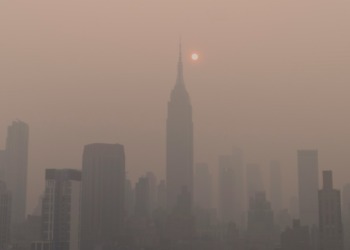The gold rush for sand – used in everything, from construction to glass to wine – is leading inexorably to a collapse of human life on Earth… unless we can do something to stop the loss of sand.
In 2013, French filmmaker Denis Delestrac made an extraordinary documentary, researching what was happening to sand and why. It is an arresting visual warning and a call to action that is at last being heard, first in the French-speaking world, and now in the English-speaking world too, thanks to an important paper put out in March 2014 by the United Nations Environment Agency (UNEP), with an arresting title: “Sand, rarer than one thinks”.
This paper, put out by UNEP’s Global Environmental Alert Service, was written by a team of a dozen researchers, including outside support from the Munk School of Global Affairs, University of Toronto. The paper is only 14 pages long and well worth reading (see here). You will note at the end a footnote in which the paper’s authors acknowledge that the starting point of their research was Denis Delestrac’s film, first aired in May 2013 on Arte TV, a bilingual channel (French-German) closely followed by the cognoscenti and literati in Europe
A few days ago, Delestrac’s film was aired on Arte TV again and I was fortunate to see it. Unfortunately, it was still shown in its French version (you can see it here).
This is one film in which climate deniers are roundly sidestepped: the excessive use of sand – well beyond its replacement capacity – caused in particular by sand-mining for the booming construction industry, not just in the United States but in the developing world too, is causing unprecedented damage to the environment. In fact, sand, after water, has become the second resource globally at risk.
Just think of what the Gulf countries are doing, for example building the famous Palm Islands off the coast of Doha that add, when both Palm Jumeirah and Palm Jebel Ali are completed (only the former was done), some 520 km to the coast of Dubai, making it the largest land reclamation project in the world. Besides the astronomical (and rising) financial cost of the project, it is having severe side-effects on the local environment, threatening marine life and damaging Dubai’s shoreline as it causes changing wave patterns.
The Palm Jumeirah seen from the International Space Station
As might be expected, environmentalists are deeply worried. But Delestrac adds a new twist to their well-known observations. Few people realize that Dubai ran into unexpected problems to obtain the needed sand for their island construction:
(1) contrary to what most people think, the sand used in construction cannot come from the desert, it is not suitable – what is needed is the well-rounded grains resulting from river and sea erosion; and
(2) construction at the Palm Islands started with sand dredged from the bottom of the near-by Persian Gulf but it quickly had to be supplemented with sand imported from much farther away, ultimately from…Australia; in fact, Australia today is a major sand exporting country.
If nothing is done to arrest the loss of sand, we will have to kiss good-bye not only to the beauty of fine sand beaches but to the very survival of our cement-based civilization. Delestrac’s film concludes with a frightening image of shorelines under water: the loss of sand combined with Climate Change, as global warming leads to the rise of the seas by an expected average of one meter, we can expect that some 100 million people living on the coastlines or on islands like the Maldives will find themselves under water by…2100.
A dramatic change in less than 85 years.
As Denis Delestrac says in his TED talk:
“By 2100, if you want to see a beach, you will have to turn to History books…”
A way out?
Perhaps using “recycled glass sand” instead of sand. That’s Denis Delestrac’s suggestion at the end of his TED talk. Glass bottles can be recycled to create a perfectly usable sand, even birds mistake it for the real thing and lay their eggs on it, and of course it can be used in construction just like real sand.
The trouble is that it’s expensive compared to sand you find on beaches or in the sea.
The real question is: how long will it take humanity to place a price on sand? That’s a job for governments. They could put on a tax, provide subsidies to recycling etc There are many policies that can be pursued to put a price on sand and make business realize how short-sighted it is in its relentless pursuit of sand-mining, literally killing the goose with the golden eggs.
Since Delestrac did his documentary in 2013, have governments reacted?
No, not really.
The only official reaction has been at the United Nations. Thumbs up for the UN staff who had the courage to put out a paper on this issue conveniently ignored by most politicians because of the huge lobbies of the sand-mining industry. Millions of dollars are at stake and big corporations won’t let go.
Here’s what the authors of the UNEP paper had to say:
“Sand and gravel represent the highest volume of raw material used on earth after water. Their use greatly exceeds natural renewal rates. Moreover, the amount being mined is increasing exponentially, mainly as a result of rapid economic growth in Asia… A large discrepancy exists between the magnitude of the problem and public awareness of it. The absence of global monitoring of aggregates extraction undoubtedly contributes to the gap in knowledge, which translates into a lack of action.”
Therefore, to raise this issue on the political agenda, there is a need for:
(1) more in-depth research;
(2) implementation of a monitoring mechanism of aggregates extraction and trade.
Some governments are receptive.
The EU, especially the Netherlands since so much of it is already “under water”, is concerned with coastal management. But it apparently pursues a “sand nourishment” policy with techniques to deposit a layer of sand on the beach or seabed – even though, as Delestrac compellingly argues in his documentary, this is hardly a “final solution”. Sand moves around and continues to disappear because of sand-mining.
California is a more promising place: there is rising enthusiasm on the part of authorities for using “recycled aggregates” (see here).
But so far, too few governments and politicians show concern. What is needed is a global solution and there is none. The obvious place to start doing this would be the United Nations. That 14-page UNEP paper is only a start.
We now know that sand is an essential resource to our survival on this planet. We cannot afford to squander it.
For more from Claude Forthomme – Do check her out on www.thingser.com










